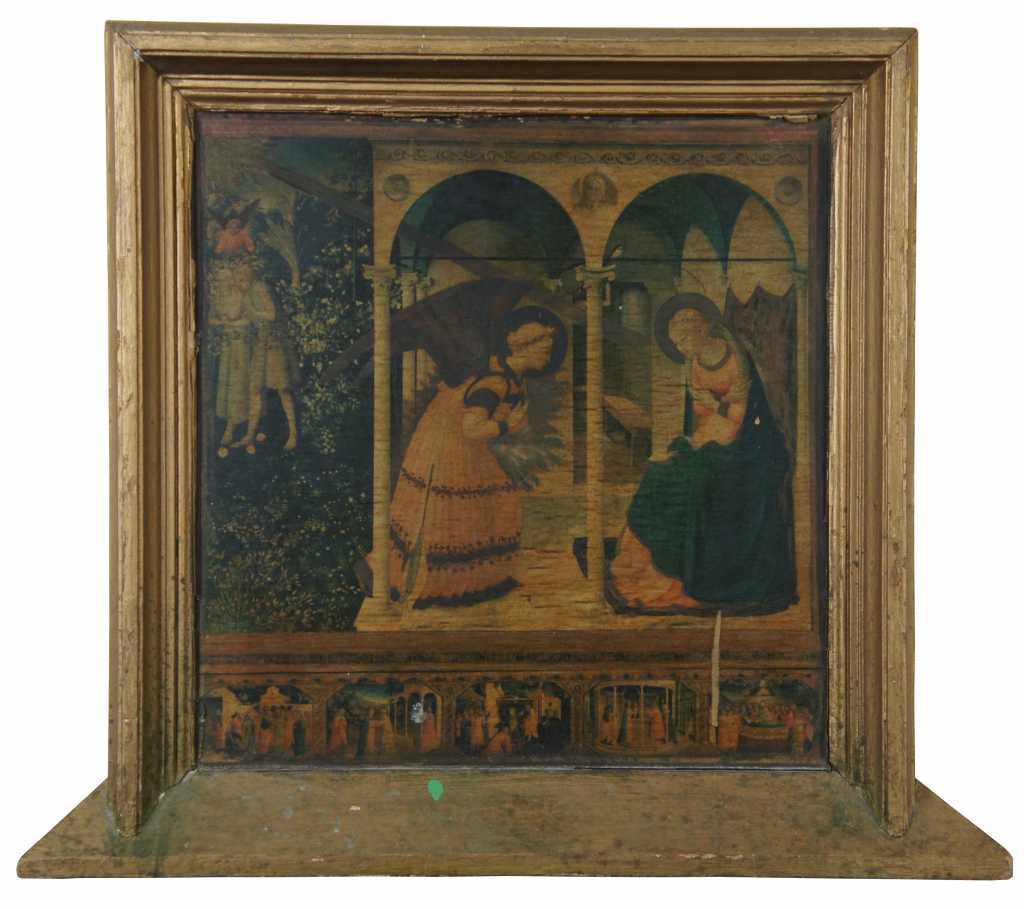
Antique Italian Renaissance Gabriel & Mary Angelico Annunciation Print on Board
Sold
Shipping:
Free Shipping Included
Delivery:
Estimated 2-15 Business Days
Payments:
Credit Card, Check, Cash, PayPal, Apple Pay, Venmo
Returns:
30 Days 100% Money Back Guarantee, Buyer Pays Return Shipping
Description
The panel painted for the altar of the Church of Gesú in Cortona, Spain (1433-34), and now at the Museo Diocesano (also in Cortona) shows Gabriel and Mary in the customary poses. The angel is standing and leaning forward on his left leg. Mary sits, the book at her side, arms crossed on her chest. The scene is an outdoor portico fitted with Corinthian columns bordering, on the outside, the closed garden of Mary’s virginity and opening, on the inside, onto Mary’s bedchamber, the thalamis virginiis. God is fitted into a cartouche above the central column. An illumined dove hovers over Mary’s head. In the deep background, at the top left of the painting, the scene of Adam’s and Eve’s expulsion from Eden links Mary to their original sin and especially to Eve’s deviation from God’s directive for which Mary’s submission to God’s new plan is supposed to compensate. At the same time, by comparison with an Annunciation produced in 1435 for the Convent of San Domenico in Fiesole (and now in a gallery of the Museo Prado, Madrid), the mood of the image is tender. The angel points to Mary with his right hand and toward the heavens with his left. The artist has painted the words detailing Gabriel’s explanation and Mary’s response in the space that divides the figures. Mary’s acceptance is represented in her direct engagement with Gabriel and a serene visage. This submission is a form of acceptance. By contrast, the fresco painted for the head of the staircase in the Convent of San Marco at Florence (1437-46) is much more somber. Here we have only Mary, the angel, the fenced-in garden, and the empty bed chamber protected by a barred window. Gabriel stands with his arms crossed, his head bowed. Mary, sitting without her book, does the same, her mouth turned down; her eyes are sad. Across the front edge of the raised, stone slab of the portico, Fra Angelico has inscribed the admonition, ""As you venerate, while passing before it, this figure of the intact virgin, beware lest you omit to say a Hail Mary."" The premium of preserving her inviolate body is represented in Mary’s reluctant submission to God’s plan. Her reluctance connects Mary with the tradition of the virile woman who is man’s equal by virtue of rejecting the concupiscence of the flesh. She wears her virginity as the proof that her sexual difference has not won her privileged audiences with God. Unlike the Cortona Madonna who, framed by a radiant halo, submits with interest to the power of the Most High, the Madonna at San Marco, whose halo is an eclipsed sphere, guards her womb from the violation of her sexual indifference.
Finally, for an individual monk’s cell at the same Convent of San Marco, Fra Angelico’s studio has rendered an Annunciation stripped to the bare essentials. The setting, more cloister than portico, lacks any ornamentation. The angel, notably, stands and appears to be instructing Mary who, kneeling on a small wooden bench with her hands folded in prayer, bears a most vacant look. Perhaps this is the work of a lesser hand than the master. Perhaps its artificial austerity in meant to inspire the meditative reveries of the cell’s inhabitant. At the very least, it shows an extreme rendering of humiliatio, and situates these extremes in the private living quarters of a cleric. It might be the devotee who occupied these quarters who is represented in the left background observing the virgin receiving her instructions. There is no way to be certain, but evidence to the contrary notwithstanding, it seems probable that the inspiration to represent so desexualized an image of Mary for the private cell of a devout man derives from an interest in reinforcing a virile model for devout women.
In general, what the Annunciations by Fra Angelico show is the range of affections that can be represented in the single moment of submission and how the options in that range can be deployed to suit, more or less, the beliefs and practices of the audience for each of those images. In the Cortona Annunciation, painted for a church in Spain, in which Mary is given more liberty in the submission to her fate, the audience would have included men and women, younger and older, upper, middle, and lower class individuals. Mary’s willing acceptance better matches the different levels of devotion that would have been represented by this wider audience. It also represents a wider acceptance of sexual difference in the subjectivation of fifteenth century European women. Mary’s sexual difference is secured by the comparison with Eve, the mother of a race bound by earthly mortality. With the Annunciation, Mary’s sexual difference is made the medium for returning divinity to the earthly realm, and for this she is most revered by the faithful. In the public and private quarters of the Monastery of San Marco, however, the image of Mary’s spiritual virginity is replaced with images of the virginitas intacta. As ""embodied angel,"" Gabriel’s mirror image, Mary represents an ideal that does not exclude men but, rather, is defined by the devotional practices of men. In these images, the significance of Mary’s sexual difference is erased.
Condition
Gently Used – Slightly peeling edges; scrapes/wear/discoloration; see pictures
Dimensions
23.25” x 20” x 2” / Sans Frame - 15.25” x 15.75” (Width x Height x Depth)










